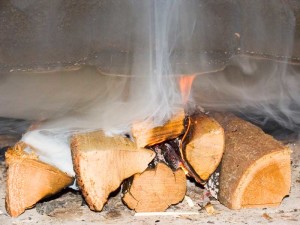Even outdoors around a campfire, no one wants to be downwind of the smoke it puts off. It is more likely a survival instinct than watery eyes that causes all of us to keep moving as the wind shifts. Smoke, especially from wood, can impart a nice flavor to food but otherwise tends to spoil fireplace fun, indoors and out.

More than one lesson can be taken home from campgrounds in regards to smoking fireplaces. Obviously, the overnight rain that left you with wet wood can be less of a problem at home with proper storage for sticks and logs. Camping also teaches those who try ‘foraging’ that newly ‘cut’ and still green wood produces even more smoke and not as much heat.
It is also generally a reminder of the part wind plays in sending smoke our way, sometimes seemingly following us. We back away from sudden sprays of lifted sparks and check to see where they landed. Rangers supervise everything more closely and nix our fires altogether if wind conditions pose dangers.
That is pretty much what needs to happen at your house until you figure out why your fireplace is smoking. It could be due to throwing in apple-tree branches that the wind cut down, snapped off the tree but still green. It could be caused by gusting winds or negative air pressure creating a down draft, especially if it happens only occasionally.
Regardless of the frequency with which it occurs, we cannot just back away from a smoking fireplace at home. Those toxic gases need to leave the house, not follow your family around it, and sudden downdrafts can blow sparks into the room. Whether an animal followed you home and is in the flue or the wind is just shifting, a smoking fireplace should force a smart move.
